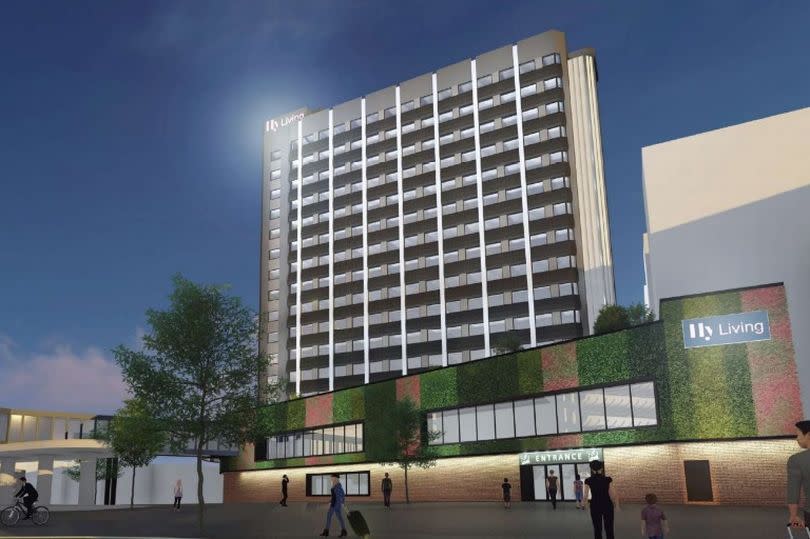'Brutalist' landmark Preston office block to be transformed into luxury flats with 'outdoor gym'

Preston's tallest building will be transformed into luxury apartments - complete with an outdoor gym and a 'living wall' of plants. The landmark 15-storey Guild Tower, which stands on Church Row – just yards from the city’s bus station and behind the Guild Hall – was most recently occupied by the Department for Work and Pensions, but has been largely empty for more than a year.
The Level entertainment complex occupies the ground floor and basement of the site – and the Local Democracy Reporting Service (LDRS) has been told there will be no impact on that venue as a result of the revamp. However, it is all change for the bulk of the block which will soon house 115 flats, mostly containing one or two bedrooms.
The apartments will run from the second floor all the way to the top of the structure, where panoramic views of Preston will be on offer to purchasers of the four, three-bedroomed ‘penthouse’ properties that will be created. The outside of the brutalist building – which dates back to 1979 – is also in line for a facelift, with its brown concrete panels to take on “a combination of grey and white tones”, according to planning documents.
Meanwhile, a so-called ‘living wall’ of plants will be wrapped around the lower two floors, while the existing flat roof currently found at second floor level will be transformed into an outdoor space for residents – complete with a short running track, exercise equipment and seating. Daniel Hughes, the agent for applicant Lindum Yates Ltd, told the meeting of Preston City Council’s planning committee at which the conversion proposal was unanimously approved, that the development would combine “the comfort of home [with] the luxury of a hotel”.
READ MORE
Dads can go for free at Blackpool's Pleasure Beach this Father's Day
Vital' late night Preston bus services saved after funding pledge
He added: “It will bring a vacant building back into use in a sustainable way, complementing the other city centre buildings and…providing residents with high-quality living. The proposed external alterations to the building will improve the appearance of the site and the contribution it makes to the character and appearance of the surrounding city centre.”
Committee chair Javed Iqbal said he did not believe the Guild Tower had ever been fully occupied “in all its life”, while fellow member Harry Landless seemed to sum up the overriding sentiment of his colleagues when he described the development as “a great use of a redundant building”. However, he struck a “slightly cynical” note of caution when he queried the appetite for yet more city centre apartments to add to all the similar schemes which have been approved for Preston in recent years.
“I just don’t know where all these people are going to come from to rent or buy these flats. Is there going to be more infrastructure in Preston to attract people to live in the city centre? Are there going to be jobs available and more reasons why people would want to come and live in our beloved city?” Cllr Landless asked.
The Guild Tower development is also the latest in a long line of city centre residential schemes which will not provide any properties that fall into the ‘affordable homes’ category. As in those other cases, the applicant successfully argued that it would render their proposal financially unviable if the firm had to meet the 30 percent quota for affordable homes that is normally demanded under Preston planning policy.
Usually, the city council insists on a ‘clawback’ mechanism in such instances – meaning that a contribution to the provision of affordable homes elsewhere in Preston can be sought from any developer that subsequently makes a larger profit on their plans than they initially forecast. However, even that safety net was not able to be deployed in the case of the Guild Tower project, because the site is also eligible for what is known as ‘vacant building credit’ – which exempts it from an affordable housing requirement in any case.
City council planning officer Patrick Marfleet told committee members that the authority did not consider the tower to have been “abandoned”, which would have rendered it ineligible for that nationwide perk, which is designed to encourage the re-use of existing properties. The applicant’s viability claims also mean they will not have to stump up the £113,000 which Lancashire County Council had requested towards the creation of the three primary and two secondary school places the authority believes will be needed as a result of the development.

 Yahoo News
Yahoo News 
